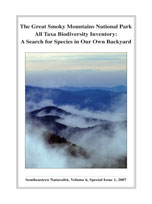Collembola are the most abundant hexapods, sometimes numbering 50,000 individuals/m2 in temperate deciduous forest. Prior to the All Taxa Biodiversity Inventory, 55 species had been reported from Great Smoky Mountains National Park (GSMNP), some of which were misidentifications. Currently, more than 200 species are recognized in GSMNP, including at least 60 species new to science and more than 100 new records. In addition, reexamination of type specimens in collections dating to the 1940s has validated a number of species that had been synonymized with other taxa, such as in the genus Morulina. One new genus has been collected, and three new species belonging to previously non-North American genera have been found (two South American, one Mediterranean). Several new records are major range extensions, such as Folsomia fimetaria, known previously from the Canadian Maritime provinces, and Hypogastrura tooliki, described from Alaska. Digital imaging and videography of live springtails is being used to more accurately render appearance and coloration and to document behaviors and interactions with other soil and litter biota. Molecular differentiation of Tomoceridae is underway in order to more reliably separate the many similar species of this common family. A Lucid-based online key for identification of southern Appalachian Collembola is under construction; where possible, this key will use characters visible with a dissecting microscope to distinguish species.
How to translate text using browser tools
1 December 2007
Biodiversity Explosion: Collembola (Springtails) of Great Smoky Mountains National Park
Ernest C. Bernard,
Kelly L. Felderhoff
ACCESS THE FULL ARTICLE

Southeastern Naturalist
Vol. 6 • No. sp2
December 2007
Vol. 6 • No. sp2
December 2007




